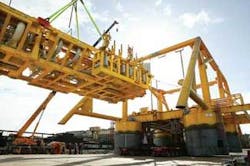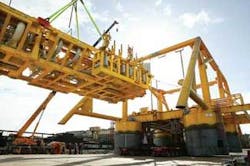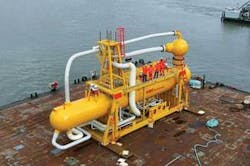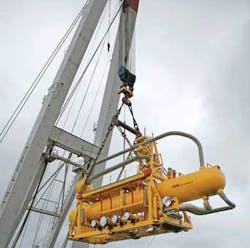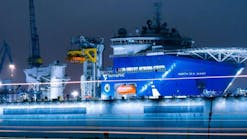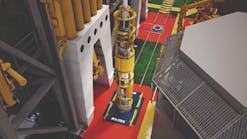World’s first subsea processing system headed for Norway
The final weld has been made on the separation unit for the world’s first commercial subsea processing unit bound for the North Sea’s Statoil-operated Tordis field. In mid-March the improved oil recovery (IOR) project reached a milestone when the construction of three FMC Technologies’ subsea modules was completed. Installation is scheduled for the third quarter of this year.
Tordis is in the Norwegian section of the North Sea in 200 m (656 ft) of water. The subsea separation system will be installed between the existing Tordis subsea field and the Gullfaks C platform. By installing a full-scale subsea separation facility, Statoil expects to improve the Tordis field’s recovery factor from 49% to 55%.
Along with other upgrades to the field, the separation system will allow Statoil to extract an additional 35 MMbbl from Tordis, with new technology accounting for approximately 19 MMbbl of the improved oil recovery. This is achieved by removing water and sand from the well stream subsea and re-injecting the water via a separate well subsea, thereby reducing the back pressure toward the Tordis field and allowing more hydrocarbons to be processed at Gullfaks C. These reserves would remain unrecoverable without the technology.
“Tordis is a perfect application of subsea separation,” says Erlend Fjøsna, Subsea Processing Systems manager, FMC Technologies. “The field is maturing, so its wells are producing more and more water. That is restricting production because the flowlines and the surface facilities do not have the capacity to transport and handle all of the extra water.”
It’s a common problem in mature fields. Operators now have three choices: they can continue to delay production and reduce ultimate recovery, they can upgrade their surface facilities and bring in additional processing equipment, or they can do some of the processing subsea. Subsea processing made the most economic sense to Statoil.
“Without subsea processing, Tordis would have to be shut down and much of the oil left in place,” says Fjøsna. “This new separation technology will increase recovery from Tordis by 35 MMbbl over the life of the field, and we believe we will see similar results in many fields over the coming years. Customers are no longer asking if it will happen, but when.”
FMC Technologies proposed a less expensive, smaller diameter vessel. By taking the gas out in the inlet section of the separator, they reduced the size of the vessel by almost 50%. FMC also performed testing to demonstrate system reliability.
Tordis test
The first major phase of testing lasted three months and took place prior to assembly of the station.
“We connected the whole system together and ran through all the auto-sequences,” says Ann Christin Gjerdseth, project manager, FMC Technologies, Kongsberg. “The goal was to check that the controls, instrumentation, and pumps all worked collectively as an integrated system. To make the testing more realistic, a field dynamic simulator was used to provide feedback on the effects of control operations. We used this to demonstrate, for example, that if you speed up the injection pump, the result is more injectivity.”
Further testing will take place until June. This primarily involves mechanical interface testing, checking that all parts fit mechanically, and that intervention can be carried out as planned. The system has been designed in a modular fashion to allow individual modules and components to be separately retrieved. The desander module will be set up in a full test loop and put through its paces.
The world’s first subsea separator is scheduled for installation on the Statoil-operated Tordis field in the North Sea in the third quarter of this year.
“With an estimated 500 kg (1,543 lb) of sand a day accumulating at the bottom of the separator, sand disposal is an important function,” Gjerdseth says. “By flushing the sand into the desander module, and then from there into the disposal well, mixed with separated water, we save the injection pump considerable wear and tear caused by the abrasive effect of sand passing through it.”
Personnel from Statoil’s operations team on Gullfaks C will familiarize themselves with the desanding function and other features of the system. Desanding is semi-automated, so operators need only press a button to initiate each set of operations.
Assembly at Tønsberg
Assembly took place in March at Tønsberg in southern Norway where the 500-ton (453-metric ton) foundation base structure and some of the modules were built. Because of the restricted craneage available, the base structure was rolled onto a barge and the two heaviest modules - the 230-metric-ton (253-ton) manifold and 170-metric-ton (187-ton) separator vessel - were lifted onto it by a floating crane vessel. The partly assembled station then was rolled back into the construction hall for installation of the desander, multiphase and water flow modules, and the two 2.3 MW pumps.
Combining cultures
“One of the biggest challenges faced during the project was to bring two very different cultures together,” says Gjerdseth. “The subsea culture as we know it today aims to achieve high reliability by keeping things simple. But a next generation subsea system, like the separation station for Tordis, is a complex processing system which must be capable of flexible, real-time control and fine-tuning, just like a topside system.”
Lifting of the subsea separator with template.
“The teamwork has been excellent, both internally between FMC Technologies, its subsidiary CDS Engineering, and its partners Framo and Grenland Group, and also with Statoil,” says Gjerdseth. “We’ve been able to draw heavily on Statoil’s expertise, and its personnel have been integrated into our teams as necessary. After all, this system is not something you build from a spec, but by bringing clever heads together.”
Once the mechanical interface testing is completed, a final leak test will be performed in June, followed by a final test of all instrumentation. The subsea separation system then will be ready for sea-fastening. It will be installed in the field by Saipem’s crane-bargeS7000. With dimensions of 40 x 25 x 19 m (131 x 82 x 62 ft), and weighing 1,250 tons (1,134 metric tons), it is believed the unit will become the heaviest subsea lift ever performed by the barge.
